#carolina bonaparte
Text
Maria Carolina of Austria in 1804:

#lmaoooo#maria carolina#maria carolina of Austria#Napoleon#napoleon bonaparte#Napoleon memes#napoleonic era#napoleonic#first french empire#french empire#history#19th century#history memes#napoleonic memes#france#France memes#Habsburgs#Habsburg
35 notes
·
View notes
Text
Pink is for Boys
"Pink or Blue? Which is intended for boys and which for girls? This question comes from one of our readers this month, and the discussion may be of interest to others. There has been a great diversity of opinion on this subject, but the generally accepted rule is pink for the boy and blue for the girl. The reason is that pink, being a more decided and stronger color, is more suitable for the boy, while blue, which is more delicate and dainty, is prettier for the girl." ~ The Infants' Department, June 1918


[Left: The Blue Boy, oil on canvas, c. 1770, by Thomas Gainsborough.
Right: The Pink Boy, oil on canvas, c. 1782, by Thomas Gainsborough.]
Pink is for girls and blue is for boys. But it hasn't always been this way. Colour coding infants as a way of denoting gender was popular in 20th century America. The problem? Pink and blue? Which is for boys and which is for girls?
In 1927 TIME Magazine asked ten of the "leading stores that sell baby equipment" which colour was for which gender. Four stores responded pink for girls and blue for boys; Macy's (Manhattan), Franklin Simon (Manhattan), Wanamaker's (Philadelphia) and Bullock's (Los Angeles). Five stores responded pink for boys and blue for girls; Best's (Manhattan), Marshall Field's (Chicago), Filene's (Boston), Maison Blanche (New Orleans) and The White House (San Francisco). Curiously Halle's (Cleveland) responded that pink was for both boys and girls.
This debate would continue and it wasn't until mid-20th century that pink for girls and blue for boys became firmly cemented in western culture.
However the idea of colour coding infants dates back to the 19th century. According to La cour de Hollande sous le règne de Louis Bonaparte in 1808 in Holland pink was used to announce the birth of a girl and blue a boy. In March 1856 Peterson's Magazine (Philadelphia, USA) advises that the ribbon on a christening cap should be blue for a boy and pink for a girl. On the 23rd of July 1893 the New York Times writes that for baby clothes it's "pink for a boy and blue for a girl!"

[The Oddie Children, oil on canvas, c. 1789, by William Beechey, via North Carolina Museum of Art.]
During the latter half of the 18th century one of the most popular outfits for young children, regardless of gender, was a white dress with a coloured sash tied around the waist. Pink and blue being the most popular colours, although other colours were worn as well. It would be tempting to assume that the colour of the sash indicated gender but there isn't clear evidence that this was the case. The Oddie Children (above) depicts Sarah, Henry, Catherine, and Jane Oddie. The three girls are all wearing white dresses; two with a blue sash one with a pink sash. We also see Henry Russell (bellow left) wearing a blue sash and Prince William (bellow right) wearing a pink sash.
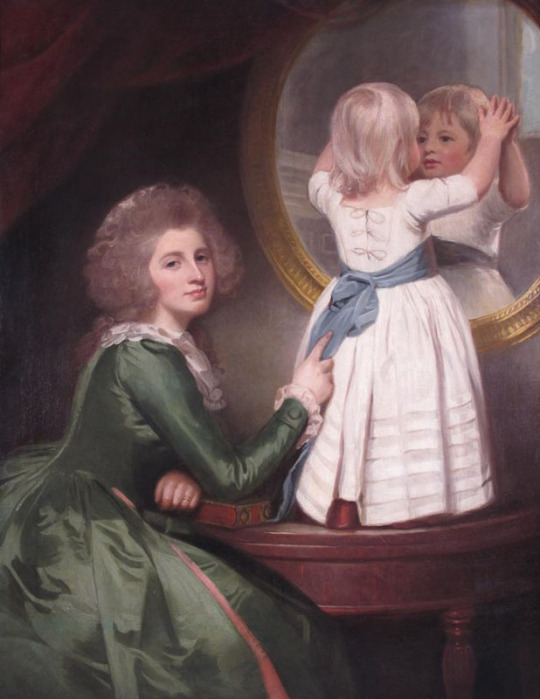
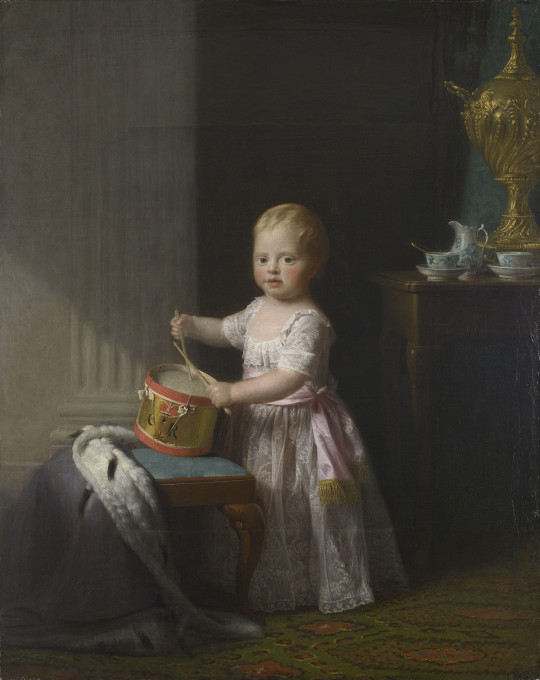
[Left: Anne Barbara Russell née Whitworth with her son Sir Henry Russell, oil on canvas, c. 1786, by George Romney, via Woolley & Wallis.
Right: Prince William, oil on canvas, c. 1767, by Allan Ramsay, via the Royal Collection Trust.]
Pink was just one of the many colours popular in 18th century English womenswear and seems to have stayed popular throughout the century. On the 3rd of January 1712 The Spectator published an article in which a man recalls seeing "a little Cluster of Women sitting together in the prettiest coloured Hoods that I ever saw. One of them was Blew, another Yellow, and another Philomot; the fourth was of a Pink Colour, and the fifth of a pale Green". On the 1st of May 1736 the Read's Weekly Journal, or British Gazetteer reports that the ladies attending the royal wedding wore gowns of "Gold stuffs, or rich Silks with Gold or Silver Flowers, or Pink or White Silks, with either Gold or Silver Netts or Trimmings;" shoes either "Pink, White or Green Silk, with Gold or Silver Lace and braid all over." On the 24th of May 1785 Charles Storer writes to Abigail Adams advising that fashionable colours in English court dress are "pink, lilac, and blue" such "as is worn at Versailles".
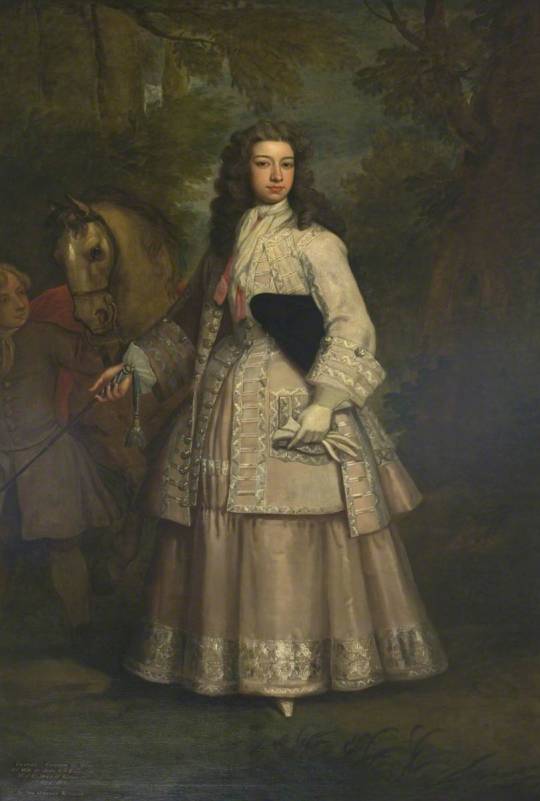
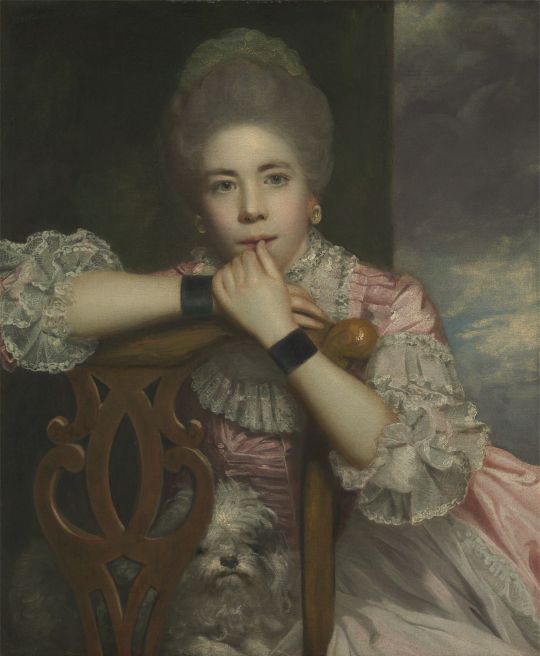
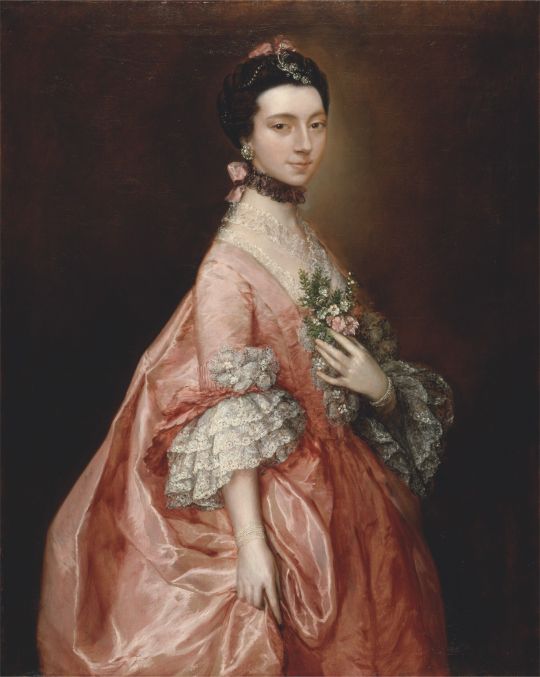
[Left: Frances, Daughter of Evelyn Pierpont, 1st Duke of Kingston, oil on canvas, c. 1700-23, by Godfrey Kneller, via Art UK.
Middle: Mrs. Abington as Miss Prue in "Love for Love" by William Congreve, oil on canvas, c. 1771, by Sir Joshua Reynolds, via Yale Center for British Art.
Right: Mary Little, later Lady Carr, oil on canvas, c. 1765, by Thomas Gainsborough, via Yale Center for British Art.]
In particular pink was popular amongst young women as the colour was associated with youth. Older women who wore pink were mocked as vain for dressing in a way that was seen as improper for their age. On the 31st of January 1754 Lady Jane Coke writes to Mrs. Eyre criticising old women who wear pink:
As for fashions in dress, which you sometimes inquire after, they are too various to describe. One thing is new, which is, there is not such a thing as a decent old woman left, everybody curls their hair, shews their neck, and wears pink, but your humble servant. People who have covered their heads for forty years now leave off their caps and think it becomes them, in short we try to out-do our patterns, the French, in every ridiculous vanity.
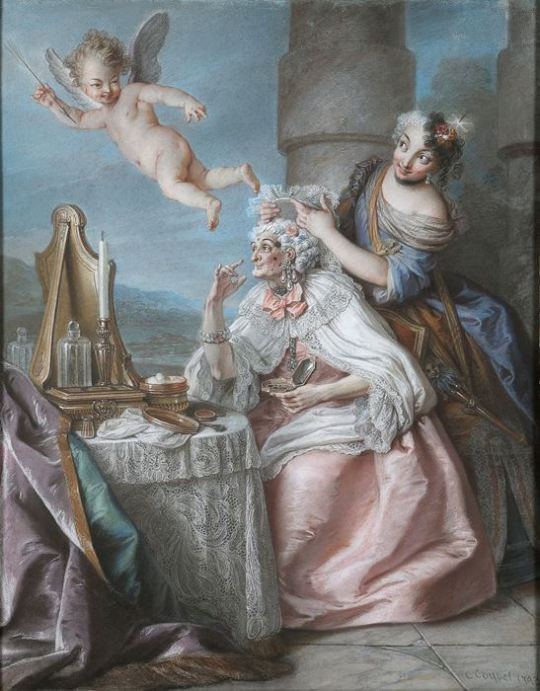
[Folly Embellishing Old Age With the Adornments of Youth, oil on canvas, c. 1743, by Charles-Antoine Coypel, via Master Art.]
For Englishmen acceptable clothing way much more limited. In A Foreign View of England in the Reigns of George I & George II Monsieur César de Saussure writes that Englishmen "do not trouble themselves about dress, but leave that to their womenfolk". He explains:
Englishmen are usually very plainly dressed, they scarcely ever wear gold on their clothes; they wear little coats called "frocks," without facings and without pleats, with a short cape above. Almost all wear small, round wigs, plain hats, and carry canes in their hands, but no swords. Their cloth and linen are of the best and finest. You will see rich merchants and gentlemen thus dressed, and sometimes even noblemen of high rank, especially in the morning, walking through the filthy and muddy streets.
César de Saussure warns that "a well-dressed person in the streets, especially if he is wearing a braided coat, a plume in his hat, or his hair tied in a bow, he will, without doubt, be called "French dog" twenty times perhaps before he reaches his destination" and is not only at risk of "being jeered at" but also "being bespattered with mud, but as likely as not dead dogs and cats will be thrown at him."
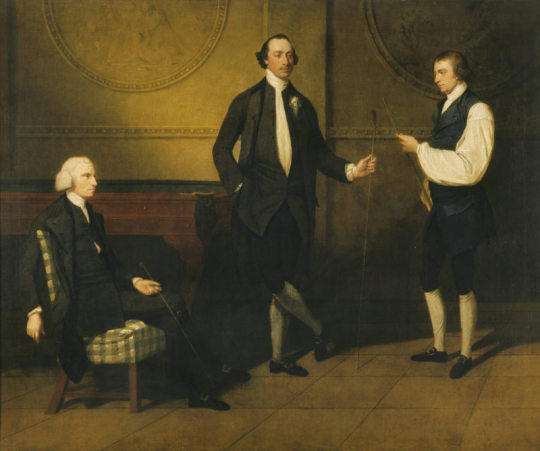
[Reverend Charles Everard Booth, Captain Griffith Booth, and an Unidentified Man playing Billiards, oil on canvas, c. 1775-9, by John Hamilton Mortimer, via the Royal Collection Trust.]
For Englishmen dressing "plainly" mostly meant wearing blacks and browns. In his book on macaroni, Pretty Gentleman, Peter McNeil found that in contrast most English menswear that he describes as generally consisting of "monochrome broadcloth" macaroni wore a variety of colours including green, orange, yellow, violet, red, white, blue, gold, silver and of course pink.
But it's not just the macaroni of the 1770s & 1780s that wore pink. We see pink in descriptions of feminine men's dress (both real and fictional) throughout the 18th century.
On the 2nd of June 1722 Sarah Osborn writes to Robert Byng:
I believe the gentlemen will wear petticoats very soon, for many of their coats were like our mantuas. Lord Essex had a silver tissue coat, and pink color lutestring waistcoat, and several had pink color and pale blue paduasoy coats, which looked prodigiously effeminate.
On the 18th of October 1729 the Universal Spectator and Weekly Journal published a story where an "effeminate" man's clothes were described as follows:
He had a flower'd pink-colour Silk Coat, with a Green-Sattin Waistcoat lac'd with Silver. Velvet Breeches, Clock'd Stockings the Colour of his Coat, Red-heel'd Pumps, a Blue Ribbon at the Collar of his Shirt, and his Sword-Hilt he embrac'd under the Elbow of his Left Arm,

[Sir Miles Stapylton, 4th Bt of Myton, oil on canvas, c. 1730-35, via Art UK.]
In The Adventures of Roderick Random (1748) the effeminate (and queer coded) Captain Whiffle is described as follows:
our new commander came on board in a ten-oared barge, overshadowed with a vast umbrella, and appeared in everything the reverse of Oakum, being a tall, thin young man, dressed in this manner: a white hat, garnished with a red feather, adorned his head, from whence his hair flowed upon his shoulders, in ringlets tied behind with a ribbon. His coat, consisting of pink-coloured silk, lined with white, by the elegance of the cut retired backward, as it were, to discover a white satin waistcoat embroidered with gold, unbuttoned at the upper part to display a brooch set with garnets, that glittered in the breast of his shirt, which was of the finest cambric, edged with right Mechlin: the knees of his crimson velvet breeches scarce descended so low as to meet his silk stockings, which rose without spot or wrinkle on his meagre legs, from shoes of blue Meroquin, studded with diamond buckles that flamed forth rivals to the sun! A steel-hilted sword, inlaid with gold, and decked with a knot of ribbon which fell down in a rich tassel, equipped his side; and an amber-headed cane hung dangling from his wrist. But the most remarkable parts of his furniture were, a mask on his face, and white gloves on his hands, which did not seem to be put on with an intention to be pulled off occasionally, but were fixed with a curious ring on the little finger of each hand.

[Henry Ingram, 7th Viscount Irwin and His Wife Anne, oil on canvas, c. 1745, by Philippe Mercier, via Art UK.]
On the 28th of July 1780 the London Courant reports:
A few days ago, a Macaroni made his appearance in the Assembly-room at Whitehaven, in the Following dress: a mixed silk coat, pink sattin waistcoat and breeches, covered with an elegant silver nett, white silk stockings with pink clocks, pink sattin shoes and large pearl buckles, a mushroom coloured stock, covered with a fine point lace; his hair dressed remarkably high, and stuck full of pearl pins.
On the 6th of August 1792 The Weekly Entertainer published Sketches and Portraits form the Life by Simon Tueopnrastus which included the following description:
Mercator was a youth of some genius and expectation, but by a strange perverseness of disposition, notwithstanding the extreme natural stiffness of his limbs, he had acquired an early attachment to the most finical and effeminate finery; so that, while yet a boy, he would exhaust every expedient of a fertile invention to procure a laced waistcoat, or the most foppish toy; would dangle a watch-string, with brass seals, from each fob, at a time when the frugal care of his parents would not permit him to wear a watch in either; and would strut in a fine pair of second-hand pink silk breeches, and a light blue coat, with all the formal dignity of—a soldier upon the parade.


[Left: Thomas King in "The Clandestine Marriage", oil on canvas, c. 1792, by Samuel De Wilde, via Yale Center for British Art.
Right: Edward Payne, oil on canvas, by Arthur Devis, via Art UK.]
While pink is mentioned in these descriptions of feminine men's dress it's not singled out as the girl colour the way pink would become in the 20th century. I would argue pink is seen as effeminate not because pink is a uniquely feminine colour but because it was used in fashionable dress. In 18th century England being interested in fashion was seen as an frivolous female trait. Men who showed too much interest in fashion were mocked and ridiculed for their gender nonconformity. "A Man must sink below the Dignity of his Nature, before he can suffer his Thoughts to be taken up on so trivial an Affair, as the Chosing, Suiting, and Adjusting the Adornments of his Person," complains a letter published on the 8th of May 1731 in Read's Weekly Journal, or British Gazetteer:
Decency of Garb ought inviolably to be preserved; nor can there be possibly an Excuse for Dressing like a Merry-Andrew: Rich and coloured Silks are in themselves effeminate, and unbecoming a Man; as are, in short, all Things that discover Dress to have been his Study 'Tis in vain for a Fop of Quality, to think his Title will protect him.


[Left: Madame de Pompadour (detail), oil on canvas, c. 1756, by François Boucher, via Alte Pinakothek.
Right: Elizabeth Wrottesley, later Duchess of Grafton, oil on canvas, c. 1764-5, by Thomas Gainsborough, via National Gallery of Victoria.]
English fashion was highly influenced by French fashion. A popular colour scheme in French fashion was green and pink. A famous example of this colour pairing can be seen in François Boucher's portrait of Madame de Pompadour (above left), she is depicted in a green gown with pink bows and flowers. You can see and example of how this style inspired English fashion in Thomas Gainsborough's portrait of Elizabeth Wrottesley (above right), who is depicted in a green gown with a floral pattern adorned with pink, white and green striped bows.
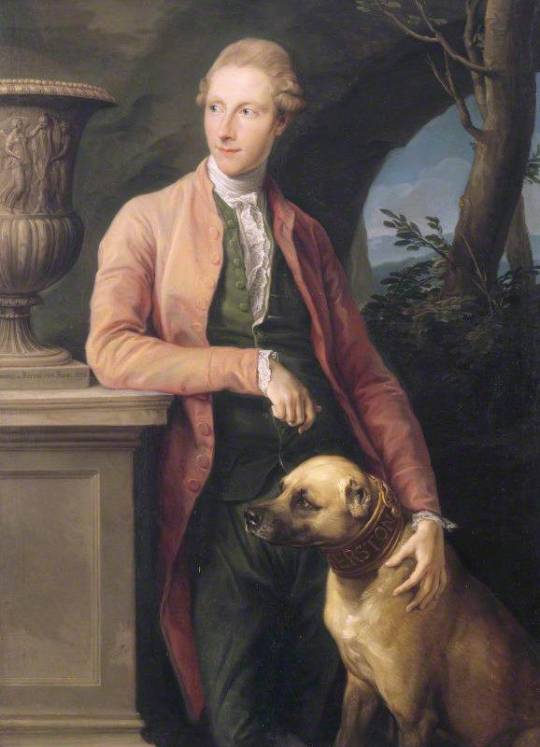
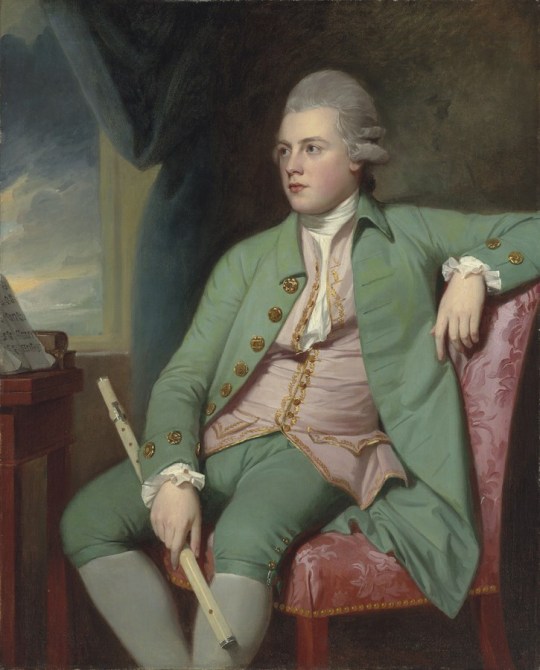
[Left: Sir Harry Fetherstonhaugh, oil on canvas, c. 1776, by Pompeo Batoni, via Wikimedia.
Right: Francis Lind, oil on canvas, c. 1775, by George Romney, via Mackinnon Fine Art.]
Fashionable Englishmen were also inspired by these French designs. Horace Walpole refers to the popularity of the colour combination writing to Lady Ossory on the 19th of February 1774 "If I went to Almack's and decked out my wrinkles in pink and green like Lord Harrington, I might still be in vogue". Almack's is referring to Almack's Assembly Rooms on Pall Mall which is believed to be the inspiration for the Macaroni Club. (see Pretty Gentleman by Petter McNeil p52-55) In a letter to Lord Harcourt on the 27th of July 1773 Walpole writes of "Macaronis lolling out of windows at Almack's like carpets to be dusted."
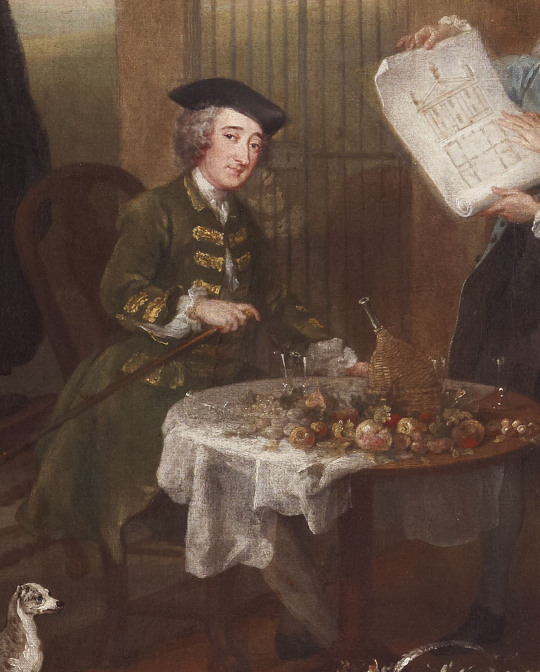

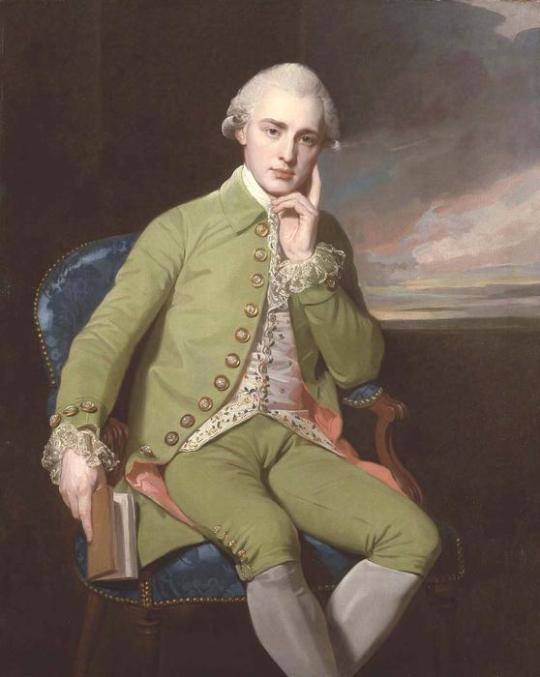
[Left: Detail of Stephen Fox from The Hervey Conversation Piece, oil on canvas, c. 1738-40, by William Hogarth, via Fairfax House.
Middle: Sir William Jones, oil on canvas, c. 1769, by Francis Cotes, via Art UK.
Right: Portrait of a Gentleman, oil on canvas, by George Romney.]
Men who wore green seem to have been just as much, if not more, at risk of being ridiculed, or even assaulted, for the colour of their clothes as those who wore pink. In Pierre Jean Grosley's A Tour to London (originally published 1772) he recalls traveling with a young English surgeon who was harassed by Londoners due to his green French frock coat:
At the first visit which he paid me in London, he informed me, that, a few days after his arrival, happening to take a walk thro' the fields on the Surry side of the Thames, dressed in a little green frock, which he had brought from Paris, he was attacked by three of those gentlemen of the mobility, who, taking him for a Frenchman, not only abused him with the foulest language, but gave him two or three slaps on the face: "Luckily, added he in French, I did not return their ill language; for, if I had, they would certainly have thrown me into the Thames, as they assured me they would, as soon as they perceived I was an Englishman, if I ever happened to come in their way again, in my Paris dress."
231 notes
·
View notes
Photo
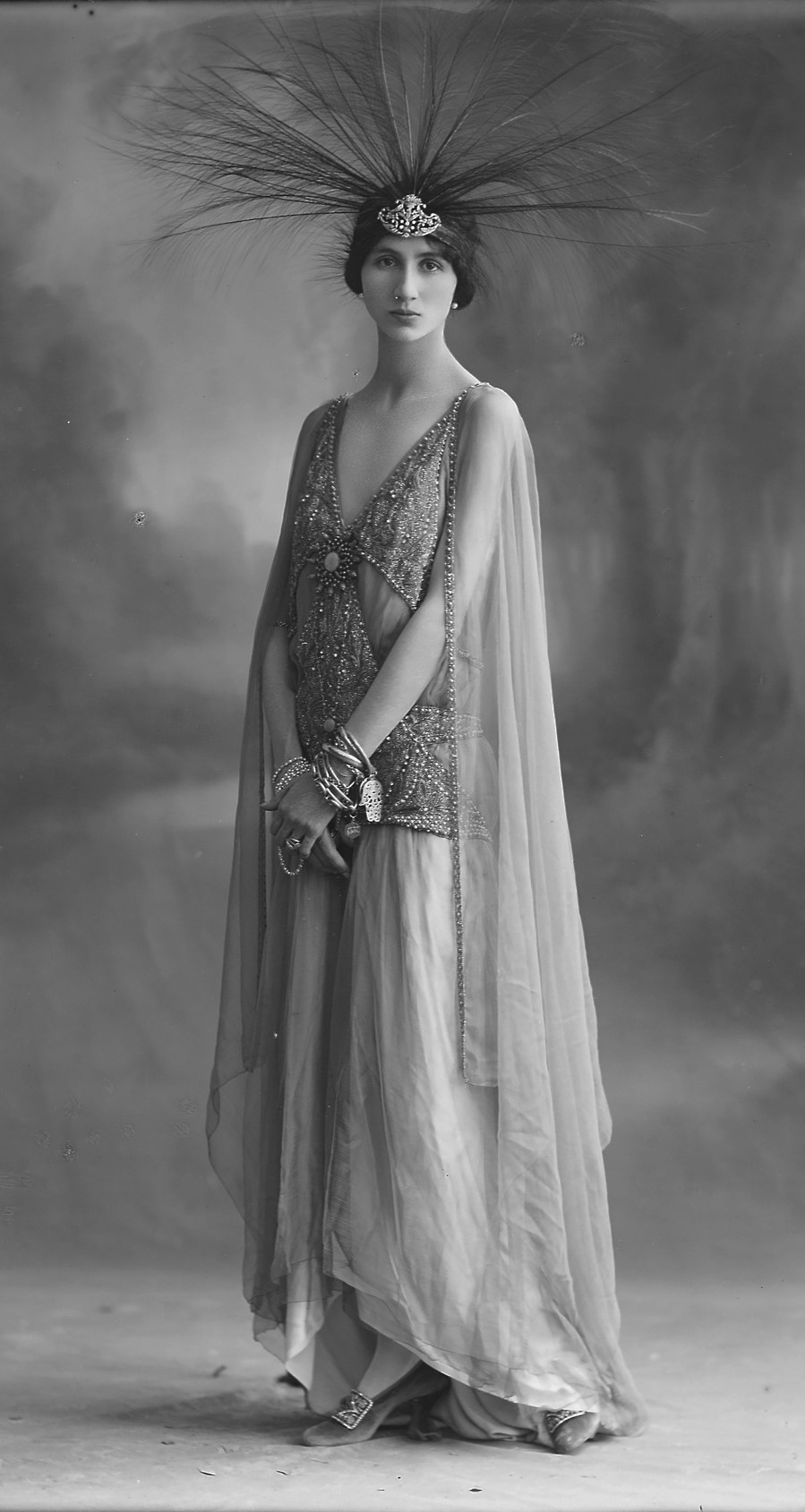
La Contessa Spalletti (La Contessa Rosa Spalletti, Countess Rosa Spalletti Lanza di Scalea), Photo by Mario Nunes Vais, 1915.
Possibly a daughter of Gabriella Rasponi Spalletti who was born in Ravenna Rasponi April 10, 1853 by Cesare Rasponi Bonanzi (1822-1886), vice consul in France, a deputy in Lanza governments and De Pretis and later senator of the Kingdom of Italy and Letizia Rasponi Marat (1832-1906), daughter of conte Giulio Rasponi, and granddaughter of Gioacchino Marat and Carolina Bonaparte (1782-1839), Napoleon’s sister.
Villa Spalletti Trivelli in Rome.
#La Contessa Spalletti#1915#portrait#photography#mario nunes vais#countess spalletti#la contessa rosa spalletti#la contessa#rosa spalletti#gli italiana#1910s#aigrette#1910s aigrettes#aigrettes#1910s fashion#antique#1910s italian fashion#italian fashion#vintage italian fashion#letizia rasponi marat#giulio rasponi#gioacchino marat#carolina bonaparte#cesare rasponi bonanzi#gabriella rasponi spalletti#Rosa Lanza dei principi di Scalea#rosa lanza di scalea#nunes vais#Countess Rosa Spalletti Lanza di Scalea#actress
79 notes
·
View notes
Note
HIIIII could i maybe ask for parrot related names :] OR just bird is okay!! okay thank you love you bye!!!!!!!
i will go tag you on the other bird themed posts i have in drafts but in the meantime! heres parrot names!
also tagging @bpdxhoardic incase you wanted to check these out too!
(Nick)Names:
Par/Parr, Parro, Parra, Parrot, Parrotte, Parrotelle, Parroter, Parrotie/Parroty, Parrotire, Parakee/Parakie/Paraky, Parakeet, Pionus, Pearly, Paint, Pfrimer, Pfrimers, Plum, Peach, Pacific, Pacifica
Cockatie, Cockatiel, Cai, Caique, Con, Conu, Conure, Caw, Congo, Cockat, Cockatoo, Crimson, Cape, Crown, Carolina, Chestnut, Cap, Caatinga, Cordill, Cordilleran, Cobalt, Caica, Chandona
Han/Hann/Hahn, Hanns/Hahns, Hans, Hya, Hyac, Hyacyn/Hyacin, Hyacinth
Macaw, Maroon, Max, Maxi, Maximillian, Moluccan, Meyer, Meyers, Madeira, Marta, Mask, Mitred, Mena
Quak/Quake, Quaker
Sun, Scarlet, Senegal, Sinu, Santarem, Santa, Sulpher/Sulphur, South, Spix, Socorro, Spec, Spectic, Spectical/Spectacle, Spectacled, Sapphire, Spot, Saffron, Scale, Scaley, Speckle, Saarika/Sarika
Lo, Lor, Lori/Lory, Lorik, Lorikee/Lorikie/Loriky, Lorikeet, Lear, Lears, Lilac, Lilacine
Budge, Budger, Budgeri, Budgerige, Budgerigar, Budgie/Budgy, Beak, Blue, Brown, Burrow, Bill, Blaze, Bona, Bonaparte, Black, Blood, Bronze
Dusk, Dusky
Eclec, Eclect, Eclectus, El
Wing, Wave, Wavy, White
Feather, Fiery, Flame, Finsch, Fan
Green, Grand, Grey/Gray, Glacer, Glaucous, Gold, Goldie, Golden, Great, Gini
Ama, Amazon, Austral, Azuero, Az, Aztec, Andean, Akeria, Akala
Yellow
Rosella, Red, Ruppell/Rupell/Rupel, Rose, Riparian, Rufous
Timneh, Tail, Turquoise, Tota
Niam, North, Nanday
Ochre, Oro, Orange
Jandaya
Vulturine
Kili, Kajla
much more here
#parrot#parrots#parrot names#names#name searching#name blog#name list#first names#nicknames#baby names#bird names#requested list#list of names#character names#name help#name hoarder#hungarian names#names of birds#name ideas#reqs open#requests are open#requests open#request#ask answered#name association#request answered
16 notes
·
View notes
Text

Napoli - Francesco Laurana - Maschio Angioino - Arco trionfale - 1479
Fondata dai Greci di Cuma, i sovrani che nei secoli si sono susseguiti sul trono di Napoli sono stati:
i Normanni:
- Ruggero I d’Altavilla conquistò la Sicilia nel 1091;
- Ruggero II (1130 - 1154): fu il primo re di una Sicilia multietnica e multireligiosa avendo accorpato in un unico regno tutti i possedimenti normanni nell’Italia Meridionale conquistando Napoli nel 1137;
- Guglielmo I (1154 - 1166)
- Guglielmo II (1166 - 1189): eresse il Duomo di Monreale;
- Tancredi (1189 - 1194)
- Guglielmo III (1194)
- Costanza d’Altavilla (1194 - 1197)
gli Svevi:
- Federico II (1198 - 1250) Stupor Mundi: a Napoli istituì l’università nel 1224;
- Corrado (1250 - 1254): dovette confrontarsi con il potere del fratellastro Manfredi;
- Corradino (1254 - 1258): fu sconfitto nella battaglia di Tagliacozzo e fatto imprigionare a Castel dell’Ovo e decapitare da Carlo d’Angiò nella piazza del mercato a Napoli, poi sepolto nella vicina Chiesa del Carmine. La dinastia degli Svevi scomparve con la morte di Manfredi nel 1266.
gli Angioini:
- Carlo I (1266 - 1285): fratello di Luigi IX il Re Santo, Conte d’Anjou, ricevette in vassallaggio la Sicilia e Napoli dal Papa che difese dagli Hohenstaufen. Edificò il Maschio Angioino, con uno stile che richiama il castello di Avignone, nel 1282;
- Carlo II (1285 - 1309): dovette rinunciare al trono di Sicilia dopo la rivolta dei Vespri Siciliani nel 1302;
- Roberto I (1309 - 1343): figlio di Maria d’Ungheria sepolta nella Chiesa di Donnaregina, fu apprezzato da Petrarca e amante della cultura e delle lettere;
- Giovanna I (1343 - 1382): fu fatta assassinare dal ramo di Durazzo degli angioini e le succedette
- Carlo (1382 - 1386)
- Ladislao (1386 - 1414)
- Giovanna II (1414 - 1435)
- Renato I (1435 - 1442)
gli Aragonesi:
- Alfonso I d’Aragona (1442 - 1458): sconfisse Renato d’Angiò e unì il tono di Napoli a quello di Sicilia e ai possedimenti della Sardegna e della Spagna occidentale. Combattè contro Milano e Genova e dotò il Maschio Angioino dell’attuale arco di trionfo;
- Ferdinando I detto Ferrante (1458 - 1494): all’inizio del suo regno dovette fronteggiare la rivolta angioina e successivamente sedò la rivolta dei baroni e si alleò con gli Sforza contro il re di Francia Carlo VIII d’Angiò. Del suo tempo la Chiesa del Gesù Nuovo;
- Alfonso II: sposò Ippolita Maria Sforza, ma dovette abdicare a causa della calata di Carlo VIII;
- Ferrandino (1494 - 1496)
- Federico I (1496 - 1503) durante il cui regno vi fu la conquista e poi la cacciata di Luigi XII re di Francia;
- Ferdinando III (1504 - 1516) dopo il quale il Regno di Napoli fu incluso in quello di Spagna prima sotto la casata degli Asburgo (con la breve parentesi della Repubblica di Masaniello fra il 1647 e il 1648) poi sotto quella dei Borbone (1700 - 1713) ed ancora sotto quella degli Asburgo d’Austria (1713 - 1734).
i Borboni:
- Carlo I (1734 - 1759): già Duca di Parma, conquistò e riunificò il Regno delle Due Sicilie anche grazie alla madre Elisabetta Farnese, seconda moglie del re di Spagna, che da Madrid influenzò la prima parte del suo regno. Riformò con Bernardo Tanucci l’amministrazione, promosse la musica (fondò il Teatro di San Carlo nella patria di Paisiello e Pergolesi), l’arte (promosse la ceramica di Capodimonte, fece costruire al Vanvitelli la reggia di Caserta del 1751 e quella che oggi è Piazza Dante oltre alla Reggia di Capodimonte dove installò la collezione Farnese) e sostenne gli scavi a Pompei ed Ercolano che iniziarono nel 1738);
- Ferdinando (1759 - 1799 e 1816 - 1825): sposò una figlia di Maria Teresa d’Austria, Maria Carolina che lo allontanò dall’influenza spagnola di Bernardo Tanucci, promosse la Marina Militare (nel 1787 fu fondata la Nunziatella), ma dovette subire una rivoluzione filo-francese (Eleonora Fonseca Pimentel, Mario Pagano, …) nel 1799 contrastata dal Cardinale Ruffo e da Fra Diavolo e la conquista napoleonica che insediò Giuseppe Bonaparte dal 1806 al 1808 e Gioacchino Murat dal 1808 al 1815 prima di diventare, con il Congresso di Vienna, Re delle Due Sicilie ed essere sepolto al Monastero di Santa Chiara;
- Francesco (1825 - 1830)
- Ferdinando II (1830 - 1859): fondò la prima ferrovia d’Italia (1839), ma fu reazionario e soprannominato il Re Bomba per come represse i moti rivoluzionari del 1848 a Messina;
- Francesco II (1859 - 1861): era figlio di Ferdinando II e di Maria Cristina di Savoia e sposò la sorella di Sissi, Maria Sofia di Baviera.
Con l’Unità, Napoli confluì nel Regno d’Italia: ecco perché la statua di Vittorio Emanuele II è presente a Palazzo Reale.
2 notes
·
View notes
Photo
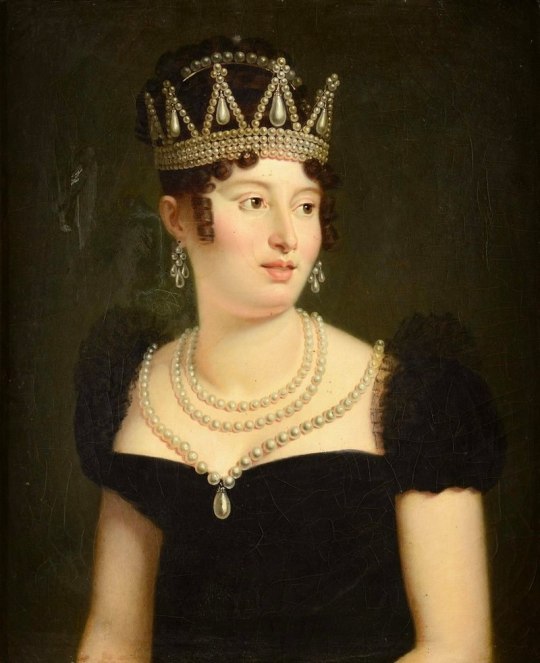
Carolina Maria Annunziata Bonaparte Murat Macdonald (25 March 1782 – 18 May 1839), better known as Caroline Bonaparte, was an Imperial French princess; the seventh child and third daughter of Carlo Buonaparte and Letizia Ramolino, and a younger sister of Napoleon I of France. She was queen of Naples during the reign of her spouse there, and regent of Naples during his absence four times: in 1812-1813, 1813, 1814, and 1815.
In 1800, Caroline married Joachim Murat Jordy, Marshal of the Empire, Prince Murat and later King of Naples, one of Napoleon's most important and notorious generals.
52 notes
·
View notes
Note
Were they just honoring the exact same family members when they named Reichstadt and FJ or...Sophie gurl please.
JGJGHJSJK you know this idea actually crossed my mind, but basically yes, it just happened that the Habsburg's name pool was as big as their gene pool. But this actually is an interesting question, so let's take a super brief look at Habsburg naming!
As frustrating as it may be for us that everyone on this dynasty had the same three names, there was a logic behind it. Historian Barbara Stollberg-Rilinger in her fantastic biography of Empress Maria Theresia puts it best:
In the House of Habsburg, Christian names were always chosen from the same limited reservoir of saints, in ever varying order. The aim was not to stamp children as one-of-a-kind individuals but to mark dynastic identity and continuity.
While Stollber-Rilinger is specifically talking about the mid 18th century, some decades before the world turned upside down and many things changed forever, this naming convention kept being truth for the Habsburgs until the end of the dynasty. For example Franz Josef's son Rudolf was named after Rudolf I (1218-1291), the first king of the Romans from the House of Habsburg. The intention of marking Rudolf 's "dynastic identity and continuity" was clear. On top of that, it was also very usual to name a child after their godparent(s), who were often family members. It's not surprising, then, that most male members of the House of Habsburg in the 19th century were called a combination of Franz, Ferdinand, Karl, Josef, Ludwig, Otto or Leopold.
With that overview on Habsburg naming done, let's move on to the two cousins in question: Napoleon "Franz", Duke of Reichstadt and Franz Josef I.

From left to right: Archduke Franz Josef, future Emperor of Austria; Napoleon II, Duke of Reichstadt; Princess Maria Carolina of Bourbon-Two Sicilies, future Duchess of Aumale.
As I said before, I don't know that much about Reichstadt other than the very basics, so I apologize beforehand if there is something wrong here, since I'm not in the loop of which are the best sources about him. In the same way, if there were any particular naming conventions in the House of Bonaparte, I'm not aware of them. That being said, let's look at the King of Rome's names!
Reichstadt's full name was Napoleon François Charles Joseph. Napoleon obviously after his father, a no brainer in my opinion: Little Napoleon's birth was basically a statement that the Bonaparte empire was here to stay. Then we have "François" whose German version would become in the name he would go by during his lifetime. This was after his godfather, his maternal grandfather Emperor Franz. "Charles" was in turn after his paternal grandfather Charles Bonaparte. Finally "Joseph" came from his second godfather, his uncle Joseph Bonaparte, King of Spain.
I find this naming very interesting, because Napoleon was creating a dynastic identity, rather than continuing it. And by throwing Emperor Franz's name in the mix, he joined the identity of his new dynasty with the Habsburgs.
Now let's look at FJ's name!
Sophie and Archduke Franz Karl's firstborn was named Franz Josef Karl. Were did these names came from was surprisingly harder to check than Reichstadt's names, because all the biographies in English that I checked on the Archive just straight up skip his baptism? I had to look for information about it in András Gerő's Hungarian biography of FJ using a machine translator. As I suspected, Emperor Franz was also the godfather of this grandson. In fact, old Franz full name was "Franz Josef Karl" so my guess is that all of FJ's names are after him.
At the time of his birth Franz Josef was several people behind the throne of Austria, yet given that there wasn't much hope in Crown Prince Ferdinand producing an heir, that he might one day succeed was not out of the realm of possibility; perhaps naming him exactly like his imperial grandfather was intentional. In any case, it followed the conventional naming rules of the House of Habsburg. By the way, the future Emperor of Austria was always just called "Franz" or "Franzi" amongst his family, he chose to ascend to the throne by the name of "Franz Josef" because he also wanted to be associated with Emperor Joseph II. Yet another example of Habsburg names marking "dynastic identity and continuity".
Now to finish the ask let's address the elephant in the room, the reason why are we looking at the names of these two cousins in particular instead of literally anyone else. Could Reichstadt had been, in fact, FJ's father?
Rumors about Reichstadt and Sophie being too friendly had in fact been going on even before Franz Josef was born. However, I think pretty much no one believes that him being the future emperor's father is possible. Let's look at what one of Reichstadt's biographers, Octave Aubry, has to say about this:
It has been asserted that Reichstadt was the father of Franz-Josef. The contention does not stand investigation. The friendship between the two lovers did not begin until after the birth of Sophie’s first child. As for her second, Maximilian, who was to be born in July, 1832, and to die in Mexico, such a filiation is not at all impossible. But in that direction everything is conjecture. If the two lovers themselves knew, they kept their secret. They loved each other: that is the only thing certain.
I've only read some fragments of this biography very superficially, but just by this you can tell that Aubry not only believes that an affair indeed happened, but also that he totally ships Reichstadt and Sophie lol. So if even him, who I believe is one of the main biographers to held the belief that they were more than close friends, doesn't buy into the rumors, then truly there isn't any evidence to back this up. About what I think about Max potentially being Reichstadt's son I already answer it in another ask.
Finally, I wanted to note that Reichstadt was very fond of his little cousin Franz Josef. He would often play with with him, and took him in his walks with Sophie. I found in Aubry's biography this very touching moment between them from when Reichstadt was already on the verge of death:
He asked to have little Franz-Josef brought to his room, for the lad’s charming ways delighted him. He stroked his hair repeatedly, and showed him little objects that he thought would amuse him and then finally held him in a tight embrace for a moment, dreaming. The child looked up at him, earnest, bored perhaps. His nurse came for him and his big cousin released him with a sigh.
I like to believe that Reichstadt was happy to share names with the cousin he loved so much.
#tl;dr: they were both named after emperor franz. i just ended up going down a ridiculously deep naming rabbit hole sorry#and now I legit feel like tearing up a bit dfgdfgk#also if you can't tell already my napoleonic subjects of interest are literally just napoleon's sons lol#napoleon ii duke of reichstadt#franz josef i of austria#franz i of austria#asks
33 notes
·
View notes
Text
Worldbuilding: Out of (Cultural) Context Problems
If your world has humans, humanoids, or anything that reasonably acts like ‘em, you’re going to have nations. Could be formal like the modern nation-states of Europe, ethnicity-based like various nomadic or herding tribes (Mongols, the Berbers, and Maasai come to mind);
could even be based on an idea and belief system, like the United States and the Jewish Diaspora.
But there will be nations, tribes, clans; and people being people, there will also be some people of foreign nations living among them.
Reasons, of course, will vary. Trade is an excellent reason to be living far from home. You’re trying to bring things people want from where there are more to where there are less, and make a nice side profit in the bargain. Though reading accounts you get the impression that some merchant-adventurers suffered from an incurable case of wanting to be somewhere that was not their native land, and trade was just how they paid the bills.
Exile is another reason. Might be for a crime, might be someone who’s fallen out of political favor; might be hapless relatives of someone who did commit treason, that don’t want to be condemned to execution or slavery. Beheaded in a civilized Empire or taking your chances with the nearby savage nomads; decisions, decisions....
Missionaries are a third possibility. Somewhere, somehow, there are those convinced they can improve the lot of others if they only show them The Way....
Note, this has fallen out of fashion with a lot of people, but I tend to be in favor of strongly advising groups who commit cannibalism to quit that. It’s not healthy - physically, mentally, or spiritually.
(Also note that there are some places, even today, where it’s not considered cannibalism if you’re killing and eating a witch, because Witches Aren’t Human. Do your research before wandering off with people you don’t know.)
A fourth reason is pure curiosity. Isabella Bird explored Japan, Korea, and the American West as a stolid middle-aged woman, because she could. And left accounts still used as useful references today. Lafcadio Hearn, tracking down folklore in the hills of Japan. James Mooney, documenting everything he could of Cherokee lore, life, and history in the Carolinas. Humans are curious beasts, and some of us just want to know things.
And there’s a fifth that crops up in history textbooks and sometimes the evening news: people living in a nation not theirs to make trouble. Political expatriates. Wild-eyed fanatics. Whoever lost the last war. There was a time New Orleans was a haunt for supporters of French royalty, who hated Bonaparte. A bunch of Quakers hot-footed it out of England, and ended up in the Atlantic Colonies. And Taiwan... well. Taiwan. That doesn’t even get into various political assassinations we can prove happened in the United Kingdom and U.S.; some carried out by spies, others by people too caught up in political axe-grinding.
If you’re writing a straightforward action pulp or sword and sorcery, why strangers are among foreign nations may not be important. Fantastical places are supposed to have people of far-off lands, adding mystery and splendor. But if your story veers into elements of mystery, war, or politics? Consider why your cultured scholar-mage is living amongst the raiding orc horde. What does he want? Why doesn’t he leave? Who’s influencing who?
After all, if the imperial ambassador winds up dead, you as a writer need to know one “nomad” had a good reason to knife him, as a filial duty to an executed parent. Or maybe they’re being framed by someone who knows they have a motive, and who’s always hated the outlander reaping honors among them....
Look outside the cultural boxes. People are complicated!
10 notes
·
View notes
Text
Events 5.12 (before 1900)
254 – Pope Stephen I succeeds Pope Lucius I, becoming the 23rd pope of the Catholic Church, and immediately takes a stand against Novatianism.
907 – Zhu Wen forces Emperor Ai into abdicating, ending the Tang dynasty after nearly three hundred years of rule.
1191 – Richard I of England marries Berengaria of Navarre in Cyprus; she is crowned Queen consort of England the same day.
1328 – Antipope Nicholas V, a claimant to the papacy, is consecrated in Rome by the Bishop of Venice.
1364 – Jagiellonian University, the oldest university in Poland, is founded in Kraków.
1497 – Pope Alexander VI excommunicates Girolamo Savonarola.
1510 – The Prince of Anhua rebellion begins when Zhu Zhifan kills all the officials invited to a banquet and declares his intent on ousting the powerful Ming dynasty eunuch Liu Jin during the reign of the Zhengde Emperor.
1551 – National University of San Marcos, the oldest university in the Americas, is founded in Lima, Peru.
1588 – French Wars of Religion: Henry III of France flees Paris after Henry I, Duke of Guise, enters the city and a spontaneous uprising occurs.
1593 – London playwright Thomas Kyd is arrested and tortured by the Privy Council for libel.
1601–1900
1743 – Maria Theresa of Austria is crowned Queen of Bohemia after defeating her rival, Charles VII, Holy Roman Emperor.
1778 – Heinrich XI, count of the Principality of Reuss-Greiz, is elevated to Prince by Joseph II, Holy Roman Emperor.
1780 – American Revolutionary War: In the largest defeat of the Continental Army, Charleston, South Carolina is taken by British forces.
1797 – War of the First Coalition: Napoleon Bonaparte conquers Venice.
1808 – Finnish War: Swedish-Finnish troops, led by Captain Karl Wilhelm Malmi, conquer the city of Kuopio from Russians after the Battle of Kuopio.
1821 – The first major battle of the Greek War of Independence against the Turks is fought in Valtetsi.
1846 – The Donner Party of pioneers departs Independence, Missouri for California, on what will become a year-long journey of hardship and cannibalism.
1862 – American Civil War: Union Army troops occupy Baton Rouge, Louisiana.
1863 – American Civil War: Battle of Raymond: Two divisions of James B. McPherson's XVII Corps turn the left wing of Confederate General John C. Pemberton's defensive line on Fourteen Mile Creek, opening up the interior of Mississippi to the Union Army during the Vicksburg Campaign.
1864 – American Civil War: The Battle of Spotsylvania Court House: Union troops assault a Confederate salient known as the "Mule Shoe", with some of the fiercest fighting of the war, much of it hand-to-hand combat, occurring at "the Bloody Angle" on the northwest.
1865 – American Civil War: The Battle of Palmito Ranch: The first day of the last major land action to take place during the Civil War, resulting in a Confederate victory.
1870 – The Manitoba Act is given the Royal Assent, paving the way for Manitoba to become a province of Canada on July 15.
1881 – In North Africa, Tunisia becomes a French protectorate.
1885 – North-West Rebellion: The four-day Battle of Batoche, pitting rebel Métis against the Canadian government, comes to an end with a decisive rebel defeat.
1888 – In Southeast Asia, the North Borneo Chartered Company's territories become the British protectorate of North Borneo.
0 notes
Text
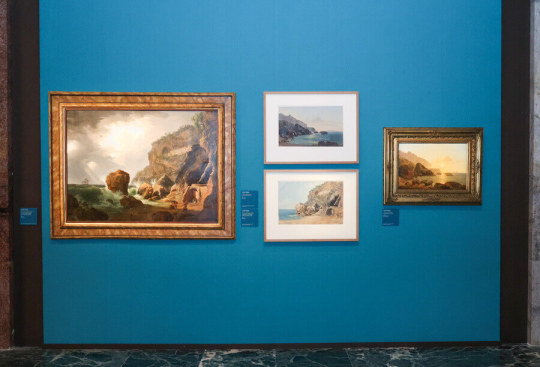

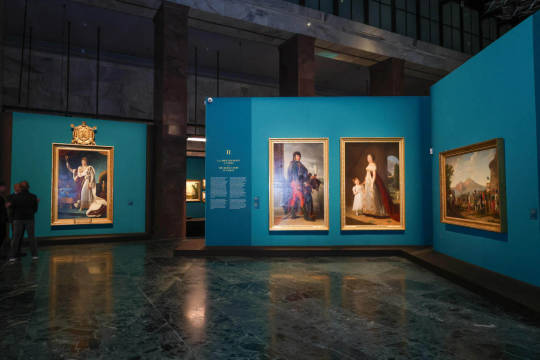
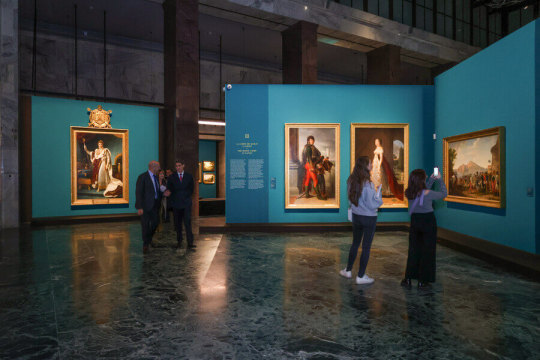
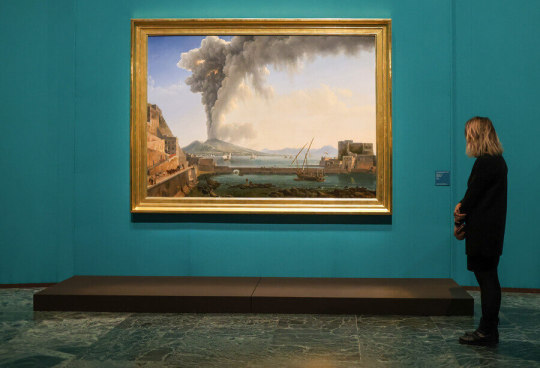
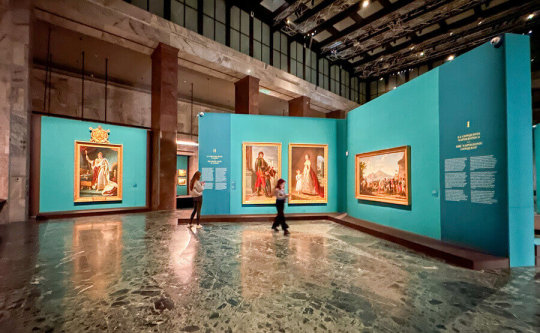
NAPOLI AL TEMPO DI NAPOLEONE. REBELL E LA LUCE DEL GOLFO
Gallerie d’Italia – Napoli, museo di Intesa Sanpaolo Dal 23 novembre 2023 al 7 aprile 2024
A cura di Sabine Grabner, Luisa Martorelli, Fernando Mazzocca e Gennaro Toscano
Intesa Sanpaolo apre al pubblico dal 23 novembre 2023 al 7 aprile 2024 alle Gallerie d’Italia a Napoli, la mostra Napoli al tempo di Napoleone. Rebell e la luce del Golfo, dedicata al pittore viennese Joseph Rebell e all’atmosfera culturale vivace e vibrante della città di Napoli negli anni dal 1808 al 1815, periodo del regno di Gioacchino Murat e Carolina Bonaparte, che videro nelle arti un mezzo efficace per promuovere la crescita civile della società napoletana.
0 notes
Video
youtube
Amazing Historical Events That Occurred on January 12th🎉 #shorts #histor...
Amazing Historical Events That Occurred Today in History January 12th
In 1552, a devastating storm hit the Dutch West Coast, killing hundreds.
In 1773, a revolutionary milestone was achieved when the first public museum in the North American colonies was established in Charlestown, South Carolina.
In 1816, France issued the Bonaparte family an edict of exclusion, exiling them from the country forever.
In 1896, Dr. Henry Smith in Davidson, North Carolina made history by taking the first X-ray photo in the United States.
In 1906, the Dow Jones Industrial Average closed above the hundred mark for the first time ever, at 100.26.
And in 1962, the Vietnam War saw its first American combat mission in Operation Chopper. This marked a major turning point in the conflict.
On January 12th, history was made in various ways. From natural disasters to groundbreaking achievements, each event left an important footprint in time
#history,
#historicalfacts,
#historical,
#historynerd,
#historicaleducation,
#historybuff,
#historicalevent,
#historicalplace,
#historicalfigure,
#historylesson,
#historicalcontext,
#historyfacts, #history, #historylovers, #facts, #ww ,#historymemes ,#historynerd ,#worldwar, #historylesson, #historybuff ,#historical ,#historylover ,#historygeek ,#historyinpictures ,#memes, #factsdaily ,#didyouknow,#funfacts,#worldhistory ,#fact, #dailyfacts, #historygram, #sciencefacts, #historic, #blackhistory, #factsonly, #war, #historyteacher, #onthisday, #knowledge
https://splinterlands.com?ref=mortonmattd1
https://hiveonboard.com?ref=m0rt0nmattd
https://ecency.com/signup?referral=m0rt0nmattd https://www.risingstargame.com?referrer=m0rt0nmattd
https://exode.io/?ref=790e9e1
https://bit.ly/WinCryptoWithMe
https://bit.ly/FreeCryptoDrip
https://bit.ly/FreeZECdrip
0 notes
Photo
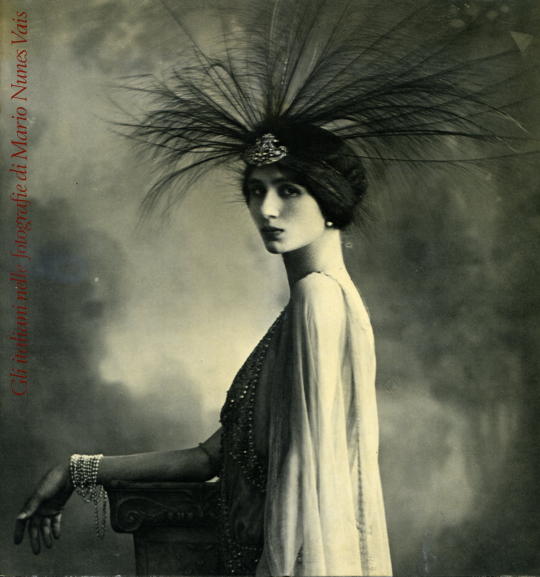
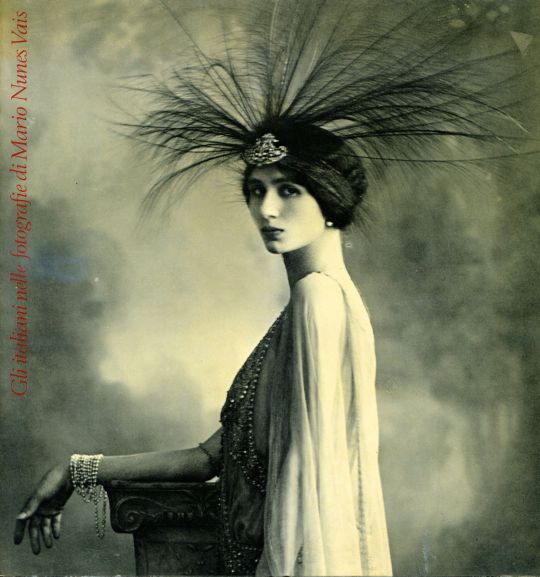
La Contessa Spalletti (La Contessa Rosa Spalletti, Countess Rosa Spalletti Lanza di Scalea), Photo by Mario Nunes Vais, 1915.
Possibly a daughter or granddaughter of Gabriella Rasponi Spalletti who was born in Ravenna Rasponi April 10, 1853 by Cesare Rasponi Bonanzi (1822-1886), vice consul in France, a deputy in Lanza governments and De Pretis and later senator of the Kingdom of Italy and Letizia Rasponi Marat (1832-1906), daughter of conte Giulio Rasponi, and granddaughter of Gioacchino Marat and Carolina Bonaparte (1782-1839), Napoleon’s sister.
Villa Spalletti Trivelli in Rome.
For sale: ebay.it
#La Contessa Spalletti#1915#portrait#countess spalletti#la contessa rosa spalletti#mario nunes vais#Countess Rosa Spalletti Lanza di Scalea#Rosa Spalletti Lanza di Scalea#Rosa Lanza di Scalea
9 notes
·
View notes
Text
Southern Hospitality Fans Criticize Leva Bonaparte For Making A Big Deal Out Of Cast’s Vacation Posts
Southern Hospitality Fans Criticize Leva Bonaparte For Making A Big Deal Out Of Cast’s Vacation Posts
Southern Cordiality season 1 got back with a fresh out of the box new episode following seven days in length break. Episode 5, named Make waves, highlighted Leva Bonaparte flying off the handle over her staff’s get-away posts on Instagram.
In the past episode, Maddi Reese took consent from Leva to go in the group on an outing to North Carolina. They previously partook in a day at a NASCAR���
View On WordPress
0 notes
Text

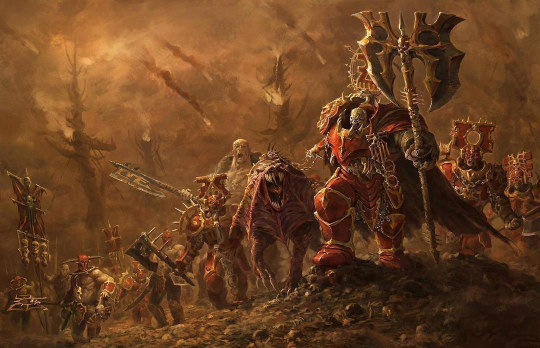

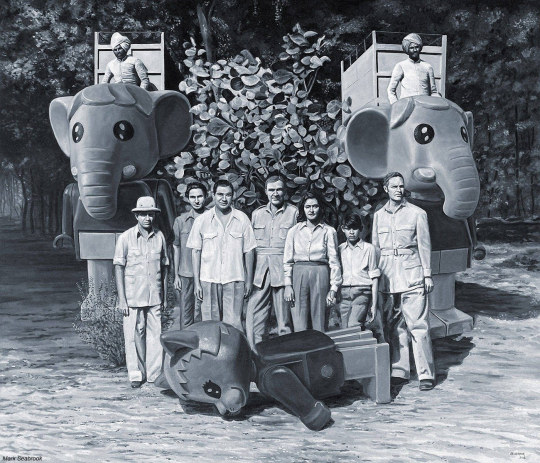
IMAGENES Y DATOS INTERESANTES DEL DIA 20 DE DICIEMBRE DE 2022
Día Internacional de la Solidaridad Humana, Día Mundial del Escepticismo, Día Mundial de la Sangría, Día Internacional de la Camisa Arrugada, Año Internacional de la Pesca y la Acuicultura Artesanales, Año Internacional del Vidrio, Año Internacional del Desarrollo Sostenible de las Montañas y Año Internacional de las Ciencias Básicas para el Desarrollo Sostenible.
Santa Ilduara, Santo Domingo De Silos y Santa Oria.
Tal día como hoy en el año 1803: Estados Unidos compra la región de Luisiana a Napoleón Bonaparte, entonces Primer Cónsul francés, por un precio total de 15 millones de dólares.
En 1860: La Asamblea de Carolina del Sur declara rota su unión con los Estados Unidos, lo que comenzó a gestar la Guerra de Secesión.
En 1973: En Madrid ocurre el atentado contra el presidente del Gobierno de España, Luis Carrero Blanco, en el que la banda terrorista ETA hace estallar una bomba cuando pasaba el vehículo en el que viajaba.
En 1988: Representantes de 49 países firman la convención contra el narcotráfico en Viena (Austria), con el que se comprometen a luchar contra el tráfico ilícito de estupefacientes y sustancias sicotrópicas.
En 2016: Ocurren varias explosiones en el mercado de pirotecnia de San Pablito, en Tultepec (México), causando la muerte a 42 personas. Es el tercer incidente que ocurre en este lugar.
Muchas más imágenes en http://obesia.com/miscelaneas
0 notes
Text
Napoleon names his brother, Joseph Bonaparte, King of Naples, and appoints other family members to various other posts.
(30th March, 1806)
Upon the outbreak of war between France and Austria in 1805, Ferdinand IV of Naples had agreed to a treaty of neutrality with Napoleon but, a few days later, declared his support for Austria. He permitted a large Anglo-Russian force to land in his kingdom. Napoleon, however, was soon victorious. After the War of the Third Coalition was shattered on 5 December at the Battle of Austerlitz, Ferdinand was subject to Napoleon's wrath. On 27 December 1805, Napoleon issued a proclamation from the Schönbrunn declaring Ferdinand to have forfeited his kingdom. He said that a French invasion would soon follow to ensure 'that the finest of countries is relieved from the yoke of the most faithless of men.'
On 31st December Napoleon commanded Joseph Bonaparte to move to Rome, where he would be assigned to command the army sent to dispossess Ferdinand of his throne. Although Bonaparte was the nominal commander-in-chief of the expedition, Marshal Masséna was in effective command of operations, with General St. Cyr second. But, St. Cyr, who had previously held the senior command of French troops in the region, soon resigned in protest at being made subordinate to Masséna and left for Paris. An outraged Napoleon ordered St. Cyr to return to his post at once.
On 8th February, 1806 the French invasion force of forty-thousand men crossed into Naples. The centre and right of the army under Masséna and General Reynier advanced south from Rome, while Giuseppe Lechi led a force down the Adriatic coast from Ancona. On his brother's recommendation, Bonaparte attached himself to Reynier. The French advance faced little resistance. Even before any French troops had crossed the border, the Anglo-Russian forces had beaten a prudent retreat, the British withdrawing to Sicily, and the Russians to Corfu. Abandoned by his allies, King Ferdinand had also already set sail for Palermo on 23rd January. Queen Maria-Carolina lingered a little longer in the capital but, on 11th February, fled to join her husband.
The first obstacle the French encountered was the fortress of Gaeta; its governor, Prince Louis of Hesse-Philippsthal, refused to surrender his charge. There was no meaningful delay of the invaders, as Masséna detached a small force to besiege the garrison before continuing south. Capua opened its gates after only token resistance. On 14th February Masséna took possession of Naples and, the following day, Bonaparte staged a triumphant entrance into the city. Reynier was quickly dispatched to seize control of the Strait of Messina and, on 9th March, inflicted a crushing defeat of the Neapolitan Royal Army at the Battle of Campo Tenese, effectively destroying it as a fighting force and securing the entire mainland for the French. On 30th March, 1806 Napoleon issued a decree installing Joseph Bonaparte as King of Naples and Sicily; the decree said as follows:
"Napoleon, by the Grace of God and the constitutions. Emperor of the French and King of Italy, to all those to whom these presents come, greetings. The interests of our people, the honour of our Crown, and the tranquillity of the Continent of Europe requiring that we should assure, in a stable and definite manner, the lot of the people of Naples and of Sicily, who have fallen into our power by the right of conquest, and who constitute a part of the Grand Empire, we declare that we recognise, as King of Naples and of Sicily, our well-beloved brother, Joseph Napoleon, Grand Elector of France. This Crown will be hereditary, by order of primogeniture, in his descendants male, legitimate, and natural, etc." Joseph's arrival in Naples was warmly greeted with cheers and he was eager to be a monarch well liked by his subjects. Seeking to win the favour of the local elites, he maintained in their posts the vast majority of those who had held office and position under the Bourbons and was anxious to not in any way appear a foreign oppressor. With a provisional government set up in the capital, Joseph then immediately set off, accompanied by General Lamarque, on a tour of his new realm. The principal object of the tour was to assess the feasibility of an immediate invasion of Sicily and the expulsion of Ferdinand and Maria-Carolina from their refuge in Palermo. But, upon reviewing the situation at the Strait of Messina, Joseph was forced to admit the impossibility of such an enterprise, the Bourbons having carried off all boats and transports from along the coast and concentrated their remaining forces, alongside the British, on the opposite side. Unable to possess himself of Sicily, Joseph was nevertheless master of the mainland and he continued his progress through Calabria and on to Lucania and Apulia, visiting the main villages and meeting the local notables, clergy and people, allowing his people to grow accustomed to their new king and enabling himself to form first-hand a picture of the condition of his kingdom. Upon returning to Naples, Bonaparte received a deputation from the French Senate congratulating him upon his accession. The King formed a ministry staffed by many competent and talented men; he was determined to follow a reforming agenda and bring Naples the benefits of the French Revolution, without its excesses. Saliceti was appointed Minister of Police, Roederer Minister of Finance, Miot Minister of the Interior and General Dumas Minister of War. Marshal Jourdan was also confirmed as Governor of Naples, an appointment made by Napoleon, and served as Bonaparte's foremost military adviser.
Bonaparte embarked on an ambitious programme of reform and regeneration, in order to raise Naples to the level of a modern state in the mould of Napoleonic France. Monastic orders were suppressed, their property nationalised, and their funds confiscated to steady the royal finances. Feudal privileges and taxes were abolished; however, the nobility was compensated by an indemnity in the form of a certificate that could be exchanged in return for lands nationalised from the Church. Provincial intendants were instructed to engage those dispossessed former monks who were willing to work in public education, and to ensure that elderly monks no longer able to support themselves could move into communal establishments founded for their care. A college for the education of young girls was established in each province. A central college was founded at Aversa for the daughters of public functionaries, and the ablest from the provincial schools, to be admitted under the personal patronage of Queen Julie.
The practice of forcibly recruiting prisoners into the army was abolished. To suppress and control robbers in the mountains, military commissions were established with the power to judge and execute, without appeal, all those brigands arrested with arms in their possession. Public works programmes were begun to provide employment to the poor and invest in improvements to the kingdom. Highways were built to Reggio. The project of a Calabrian road was completed under Bonaparte within the year after decades of delay. In the second year of his reign, Bonaparte installed the first system of public street-lighting in Naples, modelled on that operating in Paris.
Although the kingdom was not at that time furnished with a constitution, and thus Joseph's will as monarch reigned supreme, there is yet no instance of him ever adopting a measure of policy without prior discussion of the matter in the Council of State and the passing of a majority vote in favour his course of action by the counsellors. Joseph thus presided over Naples in the best traditions of Enlightened absolutism, doubling the revenue of the crown from seven to fourteen million ducats in his brief two-year reign while all the time seeking to lighten the burdens of his people rather than increase them.
Joseph ruled Naples for two years before being replaced by his sister's husband, Joachim Murat. Joseph was then made King of Spain in August 1808, soon after the French invasion.
(Information From Wikipedia)
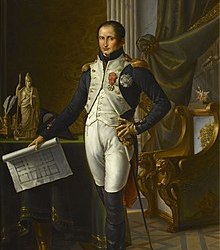
1 note
·
View note
Text
Leva Bonaparte Wikipedia: Did She Have Any Weight-Loss Surgery?
Leva Bonaparte Wikipedia: Did She Have Any Weight-Loss Surgery?
Leva Bonaparte Wikipedia: He is an American model, actress, and reality TV star, who rose to fame after participating in the seventh season of the country’s reality TV program “SOUTHERN CHARM.” She is the proprietor of nightclubs and four renowned restaurants on King Street in South Carolina, America.
She is a powerful competitor for other bar and restaurant operators in the hospitality industry…

View On WordPress
0 notes